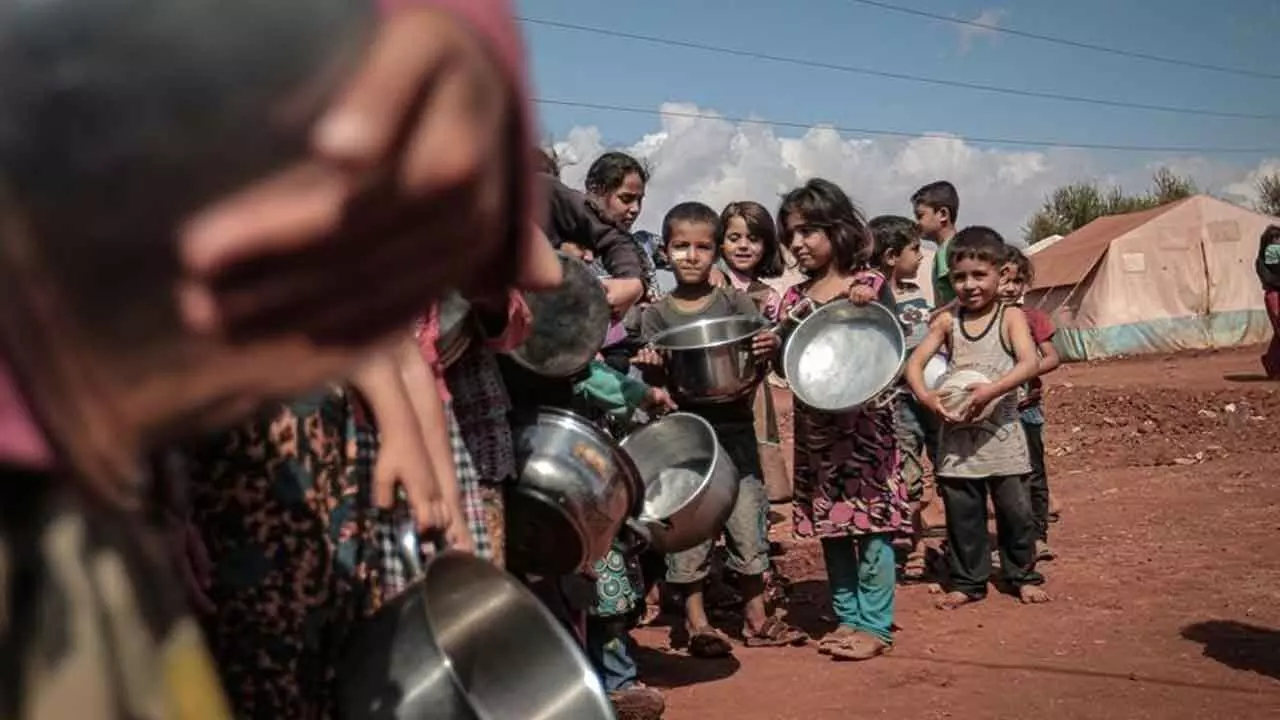Nearly 300 Mn People Faced Acute Hunger In '24: Report
Nearly 300 Mn People Faced Acute Hunger In '24: Report

‘Food crisis’ is a situation where acute food insecurity requires urgent action to protect and save lives and livelihoods at local or national levels and exceeds the national resources and capacities to respond. India was not selected among the 53 countries analysed for the report
Shagun: In 2024, more than 295 million people across 53 countries and territories experienced acute levels of hunger, according to the Global Report on Food Crises (GRFC). This was 13.7 million more people compared to 2023.
Of the total population assessed in the report, around 23 per cent faced acute food insecurity. The year 2024 was the fifth consecutive year in which this figure has remained above 20 per cent and overall the sixth consecutive year of rising acute food insecurity and child malnutrition in some of the world’s most vulnerable regions.
Conflict, economic shocks, climate extremes, and forced displacement were the key drivers of food insecurity and malnutrition around the world, with catastrophic impacts on many already fragile regions, according to the report.
The document is published annually by The Global Network Against Food Crisis (GNAFC) with analysis from the Food Security Information Network.
GNAFC is an international alliance of the United Nations, the European Union, governmental and non-governmental agencies working together to address food crises.
The report defines existence of acute food insecurity when one, some, or all dimensions of food security — food availability, access, utilisation and stability — is disrupted, whether by shocks or other factors. And a ‘food crisis’ is a situation where acute food insecurity requires urgent action to protect and save lives and livelihoods at local or national levels and exceeds the national resources and capacities to respond. India was not selected among the 53 countries analysed for the report. As the network anticipates “the most significant reduction in humanitarian funding for food and nutrition crises in the report’s history”, the report outlook said hunger shocks will likely persist into 2025.
The number of people facing catastrophic hunger (IPC/CH Phase 5) more than doubled between 2023 and 2024, to reach 1.9 million — the highest on record since the GRFC began tracking in 2016.
Analysis of malnutrition among children showed that nearly 38 million children under five were acutely malnourished. Malnutrition reached extremely high levels, including in the Gaza Strip, Mali, Sudan, and Yemen.
Catherine Russell, executive director, UNICEF, said, “In a world of plenty, there is no excuse for children to go hungry or die of malnutrition. Hunger gnaws at the stomach of a child. It gnaws, too, at their dignity, their sense of safety, and their future. How can we continue to stand by when there is more than enough food to feed every hungry child in the world?”
Even though there were some improvements in 15 countries including in Afghanistan, Kenya, and Ukraine, deteriorating acute food insecurity in 19 others, mainly in conflict-driven crises such as Nigeria, the Sudan and Myanmar, outweighed those improvements.
Key drivers:
Conflict continued to remain the top driver of acute food insecurity, affecting around 140 million people in 20 countries and territories.
“Famine has been confirmed in Sudan, while other hotspots with people experiencing catastrophic levels of acute food insecurity include the Gaza Strip, South Sudan, Haiti, and Mali,” the report said. There was also a sharp increase in hunger driven by forced displacement, with nearly 95 million forcibly displaced people, including internally displaced persons (IDPs), asylum seekers and refugees, living in countries facing food crises such as the Democratic Republic of Congo, Colombia, Sudan, and Syria out of a global total of 128 million forcibly displaced people.
Secondly, weather extremes particularly El Nino-induced droughts and floods, pushed 18 countries into food crises affecting over 96 million people. Weather shocks intensified as average air temperatures reached historic highs. Flooding was widespread and an El Nino event led to crop failure in many countries in southern Africa, said the report.
Further, some of the largest and most protracted food crises in 2024 were primarily driven by economic shocks including inflation and currency devaluation, especially in Afghanistan, South Sudan, Syrian Arab Republic, and Yemen. The report found that economic shocks drove hunger in 15 countries affecting 59.4 million people — still nearly double pre-Covid-19 levels despite a modest decline from 2023.
Call for evidence-driven and impact-focused action:
This food crisis coincided with a grim projection of funding to humanitarian food sectors dropping by up to 45 per cent amid substantial reductions by major donors and abrupt termination of funding in 2025 that has disrupted operations, including in Afghanistan, Democratic Republic of the Congo, Ethiopia, Haiti, South Sudan, the Sudan and Yemen.
Risking a deepening of acute food insecurity, nutrition services to at least 14 million children were at risk, leaving them vulnerable to severe malnutrition and death, the report warned.
“Breaking the cycle of rising hunger and malnutrition requires a bold reset — one that prioritizes evidence-driven and impact-focused action. This means pooling resources, scaling what works, and putting the needs and voices of affected communities at the heart of every response,” a statement by United Nation’s Food and Agriculture Organization (FAO) said.
The network also recommended investing in local food systems and integrated nutrition services to address long-term vulnerabilities and build resilience to shocks.
“The global hunger crisis threatens not just lives, but the stability and potential of entire societies. What is needed now is collective action so we can build a future free of hunger,” said Axel van Trotsenburg, senior managing director for Development Policy and Partnerships, World Bank.
(Courtesy: https://www.downtoearth.org.in/)

